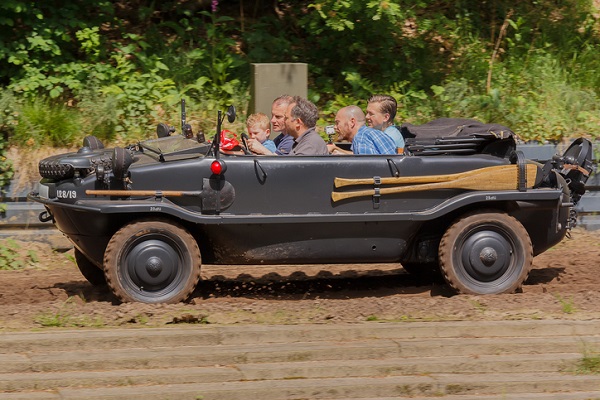Interested in Training for Mechanics? Here's What You Should Know about the Aquatic Amphicar

Although it was in production for only five years from 1960 to 1965, and the innovations it introduced were never taken up by other major car manufacturers, the Amphicar Model 770 is a curiosity worth learning about.
The world’s only mass-produced civilian amphibious passenger vehicle, it was capable of running both on land and in water, with a unique design that combined all the features of a standard road-worthy car with a two-propeller aquatic propulsion system. Over fifty years later, there’s still nothing else quite like it.
Read on to learn more about this unique piece of automotive history.
Amphibious Vehicles Before the Amphicar
While the Amphicar was the only amphibious car intended for sale to the general public, it wasn’t the first car-boat hybrid to be built. The Orukter Amphibolus, built in 1803 by Oliver Evans, supposedly drove the streets of Philadelphia before successfully wading into the Delaware River. The vehicle was never mass-produced, though, and little else is known about it.
Better known is the Volkswagen Schwimmwagen, an amphibious four-wheel drive off-roader designed and used in WWII. Although these were mass-produced in a factory in Wolfsburg, Germany, and over 14,000 units were manufactured, they never saw civilian use, and were discontinued after the war.

The Origins of the Amphicar
Hans Trippel, the inventor of the Amphicar, was actually working on amphibious car designs even before the production of the Schwimmwagen. He first began manufacturing land/water vehicles under his own name at a factory in the Saarland in Western Germany in 1932, before production was disrupted by the outbreak of WWII.
It wasn’t until the early sixties that Hans began production on the Amphicar, officially launching it at the 1961 New York Auto Show. Officially named the Amphicar Model 770, because it could achieve up to 7mph in the water and 70mph on land, the car caused quite a stir with American audiences. The next year, a promotional stunt saw the amphibious vehicle crossing the English Channel, from France to Britain, which further raised its profile.
An Interesting Case Study for Students in Car Mechanic Training
Anyone interested in training for mechanics will likely have a few questions about this strange car. The Amphicar was built with a 43 horsepower four-cylinder water-cooled Triumph Herald engine, which sits in the back of the car to power both the back wheels and the dual propellers, connected to a four-speed manual transmission. All models are convertibles, with a two-door cabriolet body, built tall with an 11.2-inch ground clearance for entering and exiting high shores. The Amphicar doors are built with a water-tight seal to prevent leakage, and although the seats are made from waterproof upholstery, the interior is otherwise standard. Interestingly, the Amphicar has no rudder, and steers in the water with its front wheels, which can reportedly make it somewhat tough to maneuver.
Although the dual land-and-water system Hans Trippel developed was never adopted by any other manufacturers, it’s still a fascinating insight into what’s possible with some clever variations on otherwise standard parts and design elements.
The End of the Amphicar
The Amphicar wasn’t particularly impressive when considered as either a car or a boat, but its dual nature did make it popular in the American market, where an estimated 3,000 units were sold out of the 3,878 that were built during its limited production run.
Unfortunately, the final sale year for the Amphicar was 1968, less than a decade after its initial release. Ultimately, the car was sold for too low a price to be profitable, given the high costs of development and manufacturing, and the company couldn’t stay afloat financially. But there’s good news for students in car mechanic training who hope to see one of these strange cars firsthand: although they require fairly significant upkeep, many Amphicars owned by collectors are still road and sea-worthy, and they can still sometimes be seen at conventions and car shows.
Are you interested in a career in the automotive industry?
Contact CATI today for information about our automotive mechanic courses.
